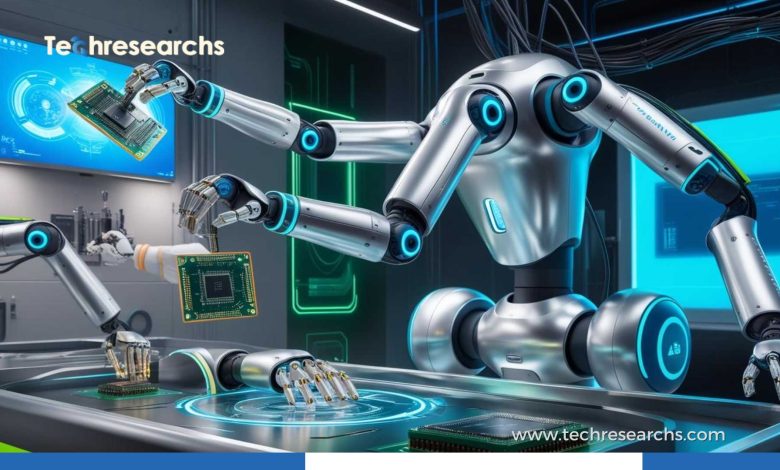Why Polyfunctional Robots Are the Next Big Thing in Robotics

Polyfunctional robots are revolutionizing the field of robotics by offering multi-tasking capabilities across various industries. Unlike traditional robots that perform a single function, these robots adapt to multiple roles, increasing efficiency and productivity. With advancements in AI and automation, polyfunctional robots are transforming sectors like manufacturing, healthcare, and logistics. In this article, we will explore their benefits, applications, and the future of this groundbreaking technology.
What Are Polyfunctional Robots?
Polyfunctional robots are advanced machines designed to perform multiple tasks seamlessly. Unlike single-purpose robots, these machines integrate artificial intelligence (AI), machine learning, and IoT technologies to adapt to different tasks efficiently. These robots are crucial for industries that require versatility, automation, and cost-effectiveness.
Key Features of Polyfunctional Robots
- Multi-tasking Ability – They can switch between various tasks, reducing operational costs.
- AI-Driven Intelligence – Enhanced decision-making capabilities through machine learning.
- Adaptability – These robots can be programmed to handle different functions within the same workflow.
- Automation & IoT Integration – Real-time data processing for improved efficiency.
- Cost-Effective – Reduces the need for multiple specialized robots.
Applications of Polyfunctional Robots
1. Manufacturing and Assembly Lines
In industrial automation, polyfunctional robots streamline assembly lines, quality checks, and material handling. Their ability to switch between tasks without requiring reprogramming makes them highly efficient.
2. Healthcare and Surgery
Robotic surgery has gained momentum, with polyfunctional robots assisting in procedures such as minimally invasive surgery, diagnostics, and patient care. These robots enhance precision and reduce human errors.
3. Logistics and Warehousing
Companies like Amazon and FedEx use AI-powered robots for sorting, packaging, and delivery operations. Their ability to handle multiple logistics tasks has optimized the supply chain industry.
4. Agriculture and Farming
Modern agriculture automation benefits from polyfunctional robots that perform seeding, watering, pest control, and harvesting with minimal human intervention.
5. Defense and Surveillance
Military and security sectors leverage these robots for surveillance, reconnaissance, bomb disposal, and rescue missions, reducing risks to human personnel.
Benefits of Polyfunctional Robots
| Benefit | Explanation |
|---|---|
| Cost Reduction | Eliminates the need for multiple specialized robots |
| Increased Productivity | Handles multiple tasks without requiring human intervention |
| Flexibility | Adapts to changing work environments |
| Enhanced Safety | Reduces workplace hazards in high-risk industries |
| Smart Automation | Utilizes AI and IoT for real-time decision-making |
Challenges in Implementing Polyfunctional Robots
- High Initial Investment – The cost of advanced robotics is still significant.
- Complex Programming – Requires sophisticated AI algorithms and regular updates.
- Maintenance and Repairs – Multi-functional systems demand more frequent servicing.
- Workforce Adaptation – Companies need skilled employees to operate these robots effectively.
The Future of Polyfunctional Robots
With ongoing AI and robotics advancements, polyfunctional robots will become even more intelligent and efficient. Future developments may include self-learning algorithms, enhanced human-robot collaboration, and improved adaptability to new industries.
Polyfunctional robots are the future of automation, driving efficiency across various industries. Their ability to perform multiple tasks with minimal intervention makes them invaluable in sectors such as manufacturing, healthcare, logistics, and defense. As technology advances, these robots will continue to reshape how businesses operate, increasing productivity and reducing operational costs.
FAQs
1. What makes polyfunctional robots different from traditional robots?
Polyfunctional robots can perform multiple tasks, whereas traditional robots are designed for a single function.
2. How do polyfunctional robots improve efficiency?
They reduce downtime by handling multiple roles within a single system, increasing overall productivity.
3. Are polyfunctional robots expensive?
Initially, they require a high investment, but in the long run, they reduce costs by replacing multiple specialized robots.
4. What industries benefit the most from polyfunctional robots?
Industries such as manufacturing, healthcare, logistics, and defense benefit significantly from their automation capabilities.
5. What are the future trends in polyfunctional robotics?
Future trends include AI-driven self-learning robots, improved human-robot interaction, and expanded industry applications.



